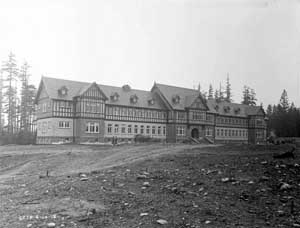On February 15, 1909, a group of influential Seattleites concerned about the growing number of undiagnosed and untreated tuberculosis cases in Seattle, form the Anti-Tuberculosis League of King County. Among the founders is railroad magnate (and future founder of the Henry Art Gallery) Horace C. Henry (1844-1928), whose teenaged son Walter has recently died of the disease. Tuberculosis, called the "white plague," is Seattle's leading cause of death. In 1911, the League will found the Henry Sanatorium (renamed Firland Sanatorium) on the present-day border of Shoreline and Seattle (at 19303 Fremont Avenue N), at the time about 12 miles north of Seattle's city limit.
The White Plague Plagues Seattle
In 1908 the United States Office of Public Health had declared Seattle's record of fighting tuberculosis to be the worst in the country. Founding League member J. V. Smith publicly declared that the whole city was a tuberculosis camp.
The League's first organized activity was to send a team of visiting nurses into the community. These nurses were charged with discovering people who had or might have tuberculosis and bringing them to the League's attention. The nurses' data showed that at least 1,000 Seattleites required treatment for the disease, and the League was immediately faced with the question of how these patients should be cared for. By July 1909, plans were underway to build a sanatorium.
The League, later renamed the Tuberculosis and Respiratory Disease Association of King County, built the Henry Sanatorium in 1911. Renamed Firland Sanatorium in 1912, it remained in service until 1973.
In 1947, Firland physicians gained access to the newly invented antibiotic wonder drugs. Streptomycin, followed by Para-amino Salicylic acid (PAS) and isoniazid, were used in combination to successfully combat tuberculosis, at least for the time being. But even at the time the bacilli's ability to quickly mutate and become resistant to the drugs was a concern. In 2002 the disease is returning in several extremely drug-resistant varieties.

